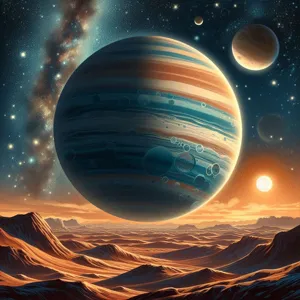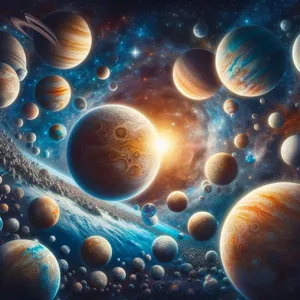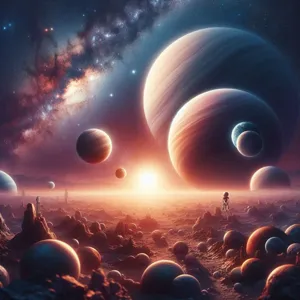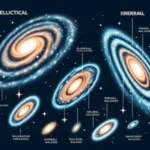In the vast expanse of our universe, celestial bodies dance in a cosmic ballet, each playing a unique role in the grand tapestry of space.
Among these fascinating entities, planets and dwarf planets stand out, but what exactly sets them apart? As we gaze up at the night sky, we often find ourselves captivated by the twinkling lights of these distant worlds, yet their classifications can be a source of confusion for many. This blog post will delve into the intriguing distinctions between planets and dwarf planets, exploring their characteristics, formation, and the criteria that define their cosmic status. Join us on this astronomical journey as we unravel the mysteries of our solar system, shedding light on the celestial divide that separates these remarkable bodies and deepening our understanding of the universe we inhabit. Whether you’re a budding astronomer or simply curious about the cosmos, this guide promises to enlighten and inspire your appreciation for the wonders beyond our planet.
1. Introduction to the Solar System

The Solar System, a vast and intricate web of celestial bodies, serves as the stage for the ongoing dance of astronomical wonders. At its heart lies the Sun, a colossal star that emits light and warmth, influencing the orbits of the planets and other objects that share its gravitational embrace. Surrounding this fiery orb, the Solar System is composed of eight major planets, each with its own unique characteristics, ranging from the rocky surfaces of Mercury and Mars to the swirling gas giants like Jupiter and Saturn, adorned with stunning rings and complex atmospheric phenomena.
Yet, the Solar System is not solely defined by these eight planets. It is a dynamic environment teeming with a multitude of smaller celestial entities, including moons, asteroids, and comets, all of which contribute to the rich tapestry of our cosmic neighborhood. Among these smaller bodies, we find the intriguing category of dwarf planets—celestial objects that share similarities with the major planets but fall short of meeting the criteria to be fully classified as such.
In this exploration of planets versus dwarf planets, we will delve into the defining characteristics that distinguish them, examining their formation, composition, and the roles they play within the broader context of our Solar System. By understanding these differences, we can gain deeper insights into the nature of our cosmic surroundings and the ongoing debates among astronomers regarding the classification of these celestial bodies. Join us as we embark on a journey through the Solar System, shedding light on the fascinating divide between planets and dwarf planets.
2. Defining Planets: The Criteria
When delving into the cosmic divide between planets and dwarf planets, it’s essential to start by understanding what qualifies an object as a planet. The International Astronomical Union (IAU) established three key criteria that an astronomical body must meet to be classified as a planet:
1. **Orbits the Sun**: To be considered a planet, an object must orbit the Sun. This criterion immediately excludes moons and other celestial bodies that orbit planets. The gravitational pull of the Sun is what keeps these objects in a defined path, creating a celestial hierarchy where planets visibly dominate their orbits.
2. **Sufficient Mass for a Nearly Round Shape**: The second criterion states that a planet must have enough mass for its gravity to pull it into a nearly round shape, also known as hydrostatic equilibrium. This characteristic gives planets their distinctive spherical form, distinguishing them from irregularly shaped asteroids or other smaller bodies that lack sufficient mass to achieve such a shape.
3. **Cleared its Orbit**: Finally, for an object to be classified as a planet, it must have cleared its orbit of other debris. This means that it has become gravitationally dominant in its vicinity, effectively sweeping away or incorporating smaller bodies orbiting within its path. This criterion is crucial, as it emphasizes the planet’s ability to maintain a clear zone around itself, reinforcing its status as a major player in the solar system.
These three criteria create a clear framework for classification, but they also highlight the complexities of cosmic categorization. While the definitions seem straightforward, they raise intriguing questions, particularly when we consider the status of dwarf planets, which, despite meeting the first two criteria, fail to clear their orbits. This nuanced distinction invites us to explore deeper into the wonders of our solar system, revealing the fascinating interplay of forces that shape our understanding of celestial bodies.
3. What Are Dwarf Planets?

Dwarf planets are fascinating celestial bodies that occupy a unique position in our solar system, distinct from both traditional planets and smaller asteroids. By definition, a dwarf planet is a round object that orbits the Sun and is not a satellite, but unlike its larger counterparts, it has not cleared its orbital neighborhood of other debris. This characteristic places dwarf planets in a category that highlights the diverse nature of celestial bodies.
One of the most well-known examples of a dwarf planet is Pluto, which was famously reclassified from its planetary status in 2006. Pluto, along with others like Eris, Haumea, and Makemake, showcases the intriguing characteristics that define this group. Dwarf planets are typically composed of rock and ice, and they can be found in various regions of the solar system, including the Kuiper Belt—a vast area beyond Neptune filled with icy bodies.
What makes dwarf planets particularly interesting is their ability to challenge our understanding of what constitutes a planet. Their relatively small size, combined with their inability to dominate their surrounding orbital zone, encourages astronomers and space enthusiasts alike to ponder the complexities of cosmic classification. Some dwarf planets, like Ceres, which resides in the asteroid belt between Mars and Jupiter, even possess unique features, such as the presence of water ice and potential for past geological activity.
As we continue to explore our solar system, the study of dwarf planets not only enriches our knowledge of planetary formation and evolution but also invites us to reconsider the criteria we use to define the very essence of what a planet is. This ongoing cosmic journey reminds us of the wonders that await us in the vastness of space, where even the smaller bodies hold significant scientific intrigue and potential for discovery.
4. Historical Context: The Classification of Celestial Bodies
In the grand tapestry of our universe, the classification of celestial bodies has evolved significantly over time, reflecting humanity’s growing understanding of the cosmos. Historically, the distinction between planets and what we now refer to as dwarf planets was not formally defined, leading to a mix of interpretations and classifications that often depended on cultural and observational biases.
For centuries, ancient civilizations identified the five known planets—Mercury, Venus, Mars, Jupiter, and Saturn—by their distinct movements across the night sky, which set them apart from the countless stars that twinkled above. The term “planet,” derived from the Greek word “planetes,” meaning “wanderer,” was primarily used to describe these celestial wanderers, with no distinction made for smaller bodies that also traversed the heavens.
As our observational tools advanced, particularly with the invention of the telescope in the 17th century, astronomers began discovering objects beyond the known planets. The asteroid belt, with its myriad small rocky bodies, was one of the first indications that our solar system contained more than just planets. However, it wasn’t until the late 19th century that the discovery of Pluto in 1930 prompted a deeper investigation into what constitutes a planet.
For decades, Pluto was celebrated as the ninth planet of our solar system, but as astronomers continued to explore the Kuiper Belt—home to many similar icy bodies—questions arose about Pluto’s classification. This culminated in the pivotal 2006 International Astronomical Union (IAU) definition, which distinguished between planets and dwarf planets based on certain criteria, such as the ability to clear their orbit around the sun.
The historical context of celestial classification reveals not only our evolving scientific understanding but also the cultural and philosophical implications of how we perceive our place in the universe. The distinction between planets and dwarf planets is not merely a matter of size or orbit; it’s a reflection of humanity’s quest for knowledge and our desire to categorize the vastness of space in an understandable way. As we continue to explore and discover new celestial bodies, this classification may very well evolve again, reminding us that the cosmos is a dynamic and ever-changing realm.
5. The Eight Major Planets: An Overview

The eight major planets of our solar system are a fascinating and diverse collection of celestial bodies, each with its own unique characteristics and features. From the blistering heat of Mercury to the frigid plains of Neptune, these planets offer a glimpse into the complexity of our cosmic neighborhood.
**Mercury** is the closest planet to the Sun and the smallest in our solar system. It boasts a surface covered in craters, much like our Moon, and experiences extreme temperature fluctuations due to its thin atmosphere. Its swift orbit around the Sun takes just 88 Earth days, making it the planet with the shortest year.
**Venus**, often referred to as Earth’s “sister planet” due to its similar size and composition, is shrouded in thick clouds of sulfuric acid. Its surface is a hellish landscape of volcanic plains and mountains, with surface temperatures hot enough to melt lead. The greenhouse effect on Venus is so strong that it traps heat, making it the hottest planet in our solar system.
**Earth**, our home planet, is a unique oasis of life. With liquid water covering about 71% of its surface and a diverse atmosphere, it is the only planet known to support life. Earth’s axial tilt and rotation create a dynamic climate system that gives rise to seasons, weather patterns, and diverse ecosystems.
**Mars**, the Red Planet, is known for its striking reddish appearance, caused by iron oxide (rust) on its surface. Mars has the largest volcano in the solar system, Olympus Mons, and evidence suggests it once had flowing water, making it a prime candidate in the search for past extraterrestrial life. The exploration of Mars has captivated scientists and enthusiasts alike, leading to numerous missions aimed at uncovering its mysteries.
**Jupiter**, the largest planet in our solar system, is a gas giant known for its Great Red Spot—a massive storm larger than Earth that has raged for centuries. Jupiter’s atmosphere is a swirling mix of gases, and it boasts an impressive collection of moons, including Ganymede, the largest moon in the solar system. Its immense gravitational pull also plays a crucial role in protecting the inner planets from potential asteroid impacts.
**Saturn**, famous for its stunning ring system, is another gas giant that captivates observers. Its rings are composed of ice particles, rocky debris, and dust, creating a breathtaking sight. Saturn is also home to a plethora of moons, with Titan being the largest and notable for its thick atmosphere and surface lakes of liquid methane.
**Uranus**, often called the “sideways planet” due to its extreme axial tilt, rotates on its side, causing its rings and moons to orbit in an unusual manner. Its blue-green color comes from methane in its atmosphere, and it is an ice giant, characterized by a thick mantle of water, ammonia, and methane ices surrounding a rocky core.
Lastly, **Neptune**, the furthest planet from the Sun, is known for its deep blue color and dynamic atmosphere, which features the fastest winds in the solar system. Like Uranus, Neptune is an ice giant, and its strong storms and vibrant weather patterns create a truly mesmerizing atmosphere.
Together, these eight planets form a diverse tapestry of worlds, each contributing to the intricate dance of our solar system. Understanding their distinct features and characteristics not only enriches our knowledge of the cosmos but also deepens our appreciation for the unique and complex environment in which we reside.
6. The Recognized Dwarf Planets of Our Solar System
In the vast expanse of our solar system, dwarf planets occupy a unique and intriguing position, bridging the gap between the celestial bodies we recognize as planets and those that are merely asteroids or comets. As of now, the International Astronomical Union (IAU) officially recognizes five dwarf planets, each with its own distinct characteristics and fascinating backstories.
**1. Pluto**
Once the ninth planet of our solar system, Pluto was reclassified as a dwarf planet in 2006, sparking passionate debates among astronomers and the public alike. Located in the Kuiper Belt, Pluto is known for its eccentric orbit and has five known moons, with Charon being the largest. Its icy surface, composed mainly of nitrogen ice, gives it a striking appearance, while its atmosphere exhibits seasonal changes, showcasing the dynamic nature of this distant world.
**2. Eris**
Discovered in 2005, Eris is slightly smaller than Pluto but more massive, making it a compelling subject of study. Also situated in the Kuiper Belt, Eris has a highly elliptical orbit that takes it much farther from the Sun than Pluto. Its surface is believed to be covered in a layer of frozen methane, giving it a bright, reflective appearance. The discovery of Eris not only led to the redefinition of what constitutes a planet but also prompted discussions about the characteristics that distinguish dwarf planets from their larger counterparts.
**3. Haumea**
Haumea stands out for its elongated shape and rapid rotation, completing a rotation in just under four hours. This unique feature is attributed to its fast spin, which causes it to flatten at the poles and bulge at the equator. Haumea is located in the Kuiper Belt and is notable for having two known moons. Its surface is covered with crystalline ice, and it is one of the few celestial bodies known to have a significant amount of water ice.
**4. Makemake**
Another member of the Kuiper Belt, Makemake was discovered in 2005 and designated as a dwarf planet in 2008. It is one of the brightest objects in the Kuiper Belt and has a surface rich in methane and possibly ethane. Makemake is also intriguing for its lack of a known atmosphere, which sets it apart from other dwarf planets. It is believed to have a cold, icy surface, making it a subject of interest for further exploration.
**5. Ceres**
Ceres is unique among dwarf planets as it resides in the asteroid belt between Mars and Jupiter, making it the only dwarf planet located in the inner solar system. Initially classified as a planet upon its discovery in 1801, Ceres was later reclassified as an asteroid before finally being designated as a dwarf planet in 2006. Ceres is intriguing for its potential to harbor water, with evidence of briny deposits on its surface, and its status as a target for future exploration.
These recognized dwarf planets not only enrich our understanding of the solar system’s diversity but also challenge our perceptions of what constitutes a planet. As our exploration of these distant worlds continues, we uncover more about their compositions, atmospheres, and the role they play in the cosmic tapestry, reminding us that the universe is full of surprises waiting to be discovered.
7. The Role of Gravity in Planetary Classification

The role of gravity in planetary classification is a fundamental aspect that separates planets from dwarf planets in our solar system. At its core, gravity is the force that shapes celestial bodies and dictates their characteristics and behaviors. When we consider how a planet is defined, one of the key criteria is its ability to maintain a spherical shape due to gravitational pull. This phenomenon occurs when a celestial body reaches a sufficient mass, allowing its gravity to overcome rigid body forces and achieve hydrostatic equilibrium, resulting in a round shape.
In contrast, dwarf planets, while also possessing a significant gravitational force, do not dominate their orbital zones. This distinction is crucial. A dwarf planet—like Pluto, Eris, or Haumea—may orbit the Sun and have enough mass for its gravity to shape it into a sphere, but it has not cleared its neighboring region of other debris. Essentially, this means that while dwarf planets can be substantial in size, they are not gravitationally strong enough to assert control over their orbital paths, allowing other objects to coexist in their vicinity.
Moreover, gravity plays a pivotal role in the formation and evolution of these celestial bodies. During the early days of the solar system, gravity influenced how materials coalesced into planets and dwarf planets. Larger bodies accumulated mass more effectively, becoming planets, while smaller bodies struggled to gather enough material to reach the necessary threshold for classification as a planet. As a result, the gravitational dynamics of the solar system have significant implications for understanding not just the nature of these bodies, but also their interactions and histories.
In summary, gravity is not merely a force; it is a defining characteristic that helps astronomers classify celestial bodies within our solar system. By examining how gravity influences the shape, formation, and orbital dynamics of planets and dwarf planets, we gain deeper insights into the cosmos and the complex relationships that govern it. Understanding this cosmic divide enriches our appreciation of the diverse objects that inhabit our universe, from the majestic planets to the intriguing dwarf planets.
8. The Discovery of Dwarf Planets: A Brief Timeline
The journey of discovering dwarf planets is a fascinating tale that reflects our evolving understanding of the cosmos. This timeline highlights key moments that have shaped the definition and recognition of these celestial bodies.
**2006: The Defining Moment**
The story begins in the early 21st century when the International Astronomical Union (IAU) convened to establish a formal definition of what constitutes a planet. The decision to classify Pluto as a “dwarf planet” rather than a full-fledged planet was monumental. This reclassification sparked debates and discussions within the astronomical community and beyond, igniting public interest in these smaller, often overlooked entities in our solar system.
**1992: The First Discovery**
Though the term “dwarf planet” wasn’t yet coined, the discovery of 1992 QB1 marked a significant milestone. This object, found beyond Neptune in the Kuiper Belt, opened the door to a new class of celestial bodies. Astronomers began to realize that Pluto was not alone; there was a vast array of similar objects lurking in the depths of our solar system.
**2003: Eris Makes Waves**
In 2003, astronomers discovered Eris, a distant object that was initially thought to be larger than Pluto. This discovery reignited the debate over Pluto’s status and highlighted the need for a clearer classification system. Eris was named a dwarf planet following the IAU’s new definition in 2006, solidifying its place in our understanding of celestial bodies.
**2005: Haumea and Makemake**
The mid-2000s saw the discovery of additional dwarf planets, including Haumea and Makemake. Haumea, recognized for its elongated shape and rapid rotation, sparked intrigue due to its unique characteristics and its two known moons. Makemake, on the other hand, was significant for being one of the brightest objects in the Kuiper Belt, further expanding the list of recognized dwarf planets and showcasing the diversity of these distant worlds.
**Ongoing Discoveries**
Since these initial findings, astronomers have continued to uncover new dwarf planets, including Sedna and others that challenge our traditional views of the solar system. Each discovery contributes to an ever-growing catalogue of celestial bodies, prompting further research into their origins, compositions, and potential for life.
Understanding this timeline not only illustrates the significant milestones in the discovery of dwarf planets but also reflects humanity’s enduring quest to explore and comprehend the universe. As we continue to gaze into the night sky, who knows what other wonders await us?
9. The Importance of Pluto: A Case Study
Pluto, once celebrated as the ninth planet in our solar system, serves as a fascinating case study in the ongoing debate about planetary classification. Discovered in 1930 by astronomer Clyde Tombaugh, Pluto captivated the public’s imagination and held a cherished place in our understanding of the cosmos for decades. However, in 2006, the International Astronomical Union (IAU) redefined the criteria for planet status, reclassifying Pluto as a dwarf planet. This decision sparked widespread discussion and controversy, highlighting the complexities of astronomical classification and our evolving understanding of celestial bodies.
Pluto’s story is not just a tale of demotion; it embodies the rich tapestry of scientific discovery. With its unique characteristics—such as a highly elliptical orbit, a rotational tilt that causes extreme seasonal changes, and a complex atmosphere composed mainly of nitrogen—Pluto challenges traditional notions of what a planet should be. The New Horizons mission, which flew by Pluto in 2015, unveiled stunning images and provided invaluable data about its geology, atmosphere, and moons, reigniting interest in this distant world.
Moreover, Pluto’s status as a dwarf planet has opened up a broader conversation about the criteria we use to define planets. The existence of other similar bodies in the Kuiper Belt, such as Eris and Haumea, raises questions about the arbitrary boundaries we draw in the cosmos. As we continue to explore our solar system and beyond, Pluto stands as a reminder that science is not static; it evolves with new discoveries, urging us to reconsider our definitions and expand our understanding of the universe.
In essence, Pluto’s reclassification serves as a pivotal moment in the history of astronomy, emphasizing the importance of adaptability in scientific paradigms. It invites us to reexamine not only our relationship with the celestial bodies that surround us but also our capacity for inquiry and wonder. As we delve deeper into the mysteries of space, Pluto remains a symbol of both nostalgia for the past and excitement for the future, illuminating the ever-expanding boundaries of our cosmic knowledge.
10. Differences in Composition and Characteristics
When delving into the intriguing realm of celestial bodies, one of the most fascinating aspects that distinguishes planets from dwarf planets lies in their composition and characteristics. At first glance, both categories may seem similar, but a closer examination reveals a tapestry of differences that help define their unique identities within our solar system.
**Composition** plays a pivotal role in this cosmic divide. Traditional planets, such as Jupiter and Saturn, are classified as gas giants and are primarily composed of hydrogen and helium, with thick atmospheres and complex weather systems. On the other hand, terrestrial planets like Earth and Mars have rocky surfaces made up of various minerals and metals. Dwarf planets, like Pluto and Eris, exhibit a hybrid nature; they often possess a mixture of ice, rock, and possibly even organic compounds. This diverse composition contributes to their distinct physical characteristics, such as surface textures and atmospheric conditions.
**Characteristics** further emphasize the differences between these two celestial classifications. Planets are typically defined by their ability to clear their orbits of other debris, a criterion they meet with relative ease due to their significant mass and gravitational pull. Conversely, dwarf planets, despite being sizable enough to be rounded by their own gravity, share their orbital space with other objects of similar size, a key reason for their classification. This inability to dominate their orbital zones gives them a unique status in the cosmic hierarchy.
Moreover, dwarf planets often exhibit intriguing characteristics that set them apart from their larger counterparts. For instance, many have highly elliptical orbits that take them far beyond the main planetary belt, leading to prolonged periods in the cold, dark reaches of space. Their surfaces can be a mesmerizing blend of icy plains, mountains, and even potential cryovolcanoes, showcasing a striking diversity that invites further exploration and study.
In summary, while both planets and dwarf planets share the celestial stage, their differences in composition and characteristics illuminate the rich complexity of our solar system. Understanding these distinctions not only enhances our knowledge of these cosmic bodies but also ignites our curiosity about the broader universe and the myriad forms of matter and energy that populate it.
11. The Debate: Should Dwarf Planets Be Considered Planets?
The classification of celestial bodies in our solar system has long been a topic of rich discussion among astronomers and space enthusiasts alike. At the heart of this debate lies the intriguing question: should dwarf planets be considered planets? This discussion stems from the 2006 redefinition of what constitutes a planet by the International Astronomical Union (IAU), which established a clear distinction between planets and dwarf planets based on specific criteria.
Proponents of dwarf planets being classified as full-fledged planets argue that many dwarf planets, such as Pluto, share numerous characteristics with the eight recognized planets. For instance, they orbit the Sun, have a spherical shape due to their own gravity, and can even host moons. Supporters of this view contend that the historical and cultural significance of these objects warrants their inclusion in the planetary family, suggesting that the term “dwarf planet” diminishes their status and unique qualities.
On the other side of the debate, some astronomers highlight the defining criterion that distinguishes dwarf planets: they have not cleared their orbital neighborhood of other debris. This characteristic implies a difference in dominance within their celestial environments compared to the traditional planets. Critics of the idea of reclassifying dwarf planets argue that maintaining this distinction helps clarify our understanding of the solar system’s structure and evolution.
As the debate unfolds, it leads to broader questions about the nature of classification itself. Should our cosmic categories evolve with our growing understanding of these celestial bodies? Or should we adhere to a stricter definition that maintains traditional boundaries?
Ultimately, this discussion reflects humanity’s quest to comprehend our place in the universe. Whether or not dwarf planets are considered planets may seem like a technical detail, but it underscores our ongoing exploration and the ever-evolving nature of scientific understanding. As we continue to discover more about the cosmos, including the potential for even more dwarf planets, the conversation around their classification is sure to remain a hot topic among astronomers and enthusiasts for years to come.
12. The Impact of Discoveries on Our Understanding of the Cosmos
The cosmos is an ever-evolving tapestry of knowledge, and with each new discovery, our understanding of celestial bodies, including planets and dwarf planets, shifts and deepens. Over the past few decades, advancements in technology and exploration have unveiled a plethora of new information, reshaping our perceptions of what constitutes a planet and how we classify these diverse entities.
Consider the 2006 reclassification of Pluto—a momentous event that sparked intense debates among astronomers and enthusiasts alike. Once considered the ninth planet of our solar system, Pluto was demoted to a dwarf planet due to the introduction of the “clearing its orbit” criterion. This pivotal decision not only redefined Pluto’s status but also prompted a reevaluation of other celestial bodies, such as Eris and Haumea, which share similar characteristics. The impact of such discoveries goes far beyond mere classification; they challenge our fundamental understanding of the solar system’s architecture, the formation of celestial bodies, and the very nature of planetary science.
Moreover, missions like NASA’s New Horizons, which flew by Pluto in 2015, have provided breathtaking images and invaluable data, revealing a world of complexity and intrigue previously hidden in the shadows of our solar system. Every new piece of information, whether from distant exoplanets or our own backyard, adds layers to our cosmic narrative, compelling us to reconsider what we know and explore the uncharted territories of our universe.
As we continue to push the boundaries of our knowledge, each discovery serves as a reminder of how much there is yet to learn. The cosmic divide between planets and dwarf planets is but a small part of a much larger story, one filled with the promise of revelations that could redefine our place in the universe. In this ongoing quest for understanding, it becomes clear that our perceptions and classifications are not static; they are dynamic reflections of our evolving relationship with the cosmos.
13. Future Exploration: What Lies Ahead for Planets and Dwarf Planets
As our understanding of the universe expands, so too does our ambition to explore its many wonders. The future of space exploration promises exciting opportunities for both planets and dwarf planets, each offering unique insights into the origins and workings of our solar system.
For the planets, missions to Mars are gearing up for unprecedented exploration. NASA’s Artemis program aims to return humans to the Moon by the mid-2020s, paving the way for deeper explorations of the Red Planet. Robotic missions, such as the Mars Sample Return project, are set to bring back Martian soil and rock samples, potentially answering profound questions about the possibility of life beyond Earth.
Meanwhile, the outer reaches of our solar system beckon an equally compelling quest for knowledge. Dwarf planets like Pluto and Eris are on the radar of space agencies, with missions like NASA’s New Horizons providing an initial glimpse of their enigmatic surfaces. The data collected from New Horizons has ignited interest in further exploration, possibly through future missions aimed at studying the Kuiper Belt and its celestial inhabitants.
Additionally, the upcoming James Webb Space Telescope promises to enhance our understanding of both planets and dwarf planets by observing them in unprecedented detail, exploring their atmospheres, compositions, and even the potential for hosting life.
As technology advances, the divide between planets and dwarf planets could shrink, offering new opportunities for comparative studies that enhance our understanding of planetary formation and evolution. The upcoming years will be pivotal, as we prepare to embark on new journeys through our solar system, unraveling the mysteries of these celestial bodies and, in turn, deepening our understanding of our place in the cosmos. With each mission, we inch closer to answering the big questions about the universe—and discovering what lies beyond.
14. Conclusion: The Cosmic Divide and Its Significance
In conclusion, the distinction between planets and dwarf planets is not merely a matter of classification but a reflection of our evolving understanding of the cosmos. This cosmic divide highlights the complexities of celestial bodies that inhabit our solar system, revealing the rich tapestry of formation, structure, and dynamics that govern them.
Planets, with their ability to clear their orbits and dominate their gravitational neighborhoods, stand as the giants of our solar system. They remind us of the powerful forces at play in the universe, shaping not just their own existence but also influencing the trajectories of countless smaller bodies. In contrast, dwarf planets like Pluto and Eris challenge our preconceived notions and invite us to reconsider what it means to be a planet. Their presence serves as a humbling reminder of the diversity of worlds that exist beyond our immediate perception and the ongoing journey of discovery that astronomy embodies.
The significance of understanding this cosmic divide extends beyond mere taxonomy; it touches upon the philosophical implications of how we categorize knowledge and define our place in the universe. As we continue to explore and study these celestial entities, we gain insights not only into the origins of our solar system but also into the nature of planetary formation and the potential for life beyond Earth.
Ultimately, the dialogue surrounding planets and dwarf planets enriches our cosmic perspective, urging us to embrace the complexities of the universe and to remain curious explorers in our quest for knowledge. As we look to the stars, let us celebrate the wonders of both planets and dwarf planets, recognizing that each contributes uniquely to the grand narrative of the cosmos.
15. Further Reading and Resources on Planets and Dwarf Planets
To deepen your understanding of the fascinating distinctions between planets and dwarf planets, there are a plethora of resources available that cater to both casual stargazers and serious astronomy enthusiasts alike. Here are some valuable recommendations to guide your exploration:
1. **Books**:
– “The Solar System: A Visual Exploration of the Planets, Moons, and Other Celestial Bodies” by David A. Aguilar offers stunning visuals alongside engaging text, making complex concepts accessible to readers of all ages.
– “Planets and Dwarf Planets: A Practical Guide” by Dr. Sarah Williams delves into the specifics of our solar system’s inhabitants, providing insightful comparisons between full-fledged planets and their smaller counterparts.
2. **Websites**:
– NASA’s official website provides a treasure trove of information, including up-to-date research, mission data, and detailed profiles of both planets and dwarf planets. Their interactive features allow you to virtually traverse the solar system.
– The International Astronomical Union (IAU) website is an authoritative source on the definitions of celestial categories, including the criteria that distinguish planets from dwarf planets.
3. **Documentaries and Videos**:
– The documentary series “Cosmos: A Spacetime Odyssey,” hosted by Neil deGrasse Tyson, offers captivating insights into the universe, including segments focused on the solar system’s structure and its various celestial bodies.
– youtube channels like “PBS Space Time” and “Fraser Cain” provide engaging videos that break down complex astronomical concepts into digestible, entertaining presentations.
4. **Podcasts**:
– “StarTalk Radio” combines astrophysics with pop culture, featuring discussions on planets and dwarf planets that appeal to both the scientifically curious and the casual listener.
– “Planetary Radio,” hosted by the Planetary Society, covers a wide range of topics related to space exploration, including interviews with scientists and engineers who are on the forefront of planetary research.
5. **Online Courses**:
– Platforms like Coursera and edX offer free or low-cost courses on astronomy and planetary science, allowing you to learn from esteemed institutions and expand your knowledge on the cosmos at your own pace.
By utilizing these resources, you can enhance your comprehension of the cosmic divide between planets and dwarf planets, enriching your appreciation for the intricacies of our universe. Whether you’re looking to deepen your scientific knowledge or simply satisfy your curiosity, there’s a wealth of information waiting to be discovered.
As we wrap up our exploration of the cosmic divide between planets and dwarf planets, we hope you’ve gained a deeper appreciation for the fascinating complexities of our solar system. Understanding the distinctions—ranging from size and orbital characteristics to their unique roles in our celestial narrative—enriches our knowledge of the universe and its diverse inhabitants. Whether you’re gazing up at the night sky or diving into research, we encourage you to ponder the remarkable differences and similarities that define these celestial bodies. As we continue to uncover the mysteries of space, may your curiosity be ignited, leading you to further explore the wonders that lie beyond our Earthly realm. Keep looking up!






